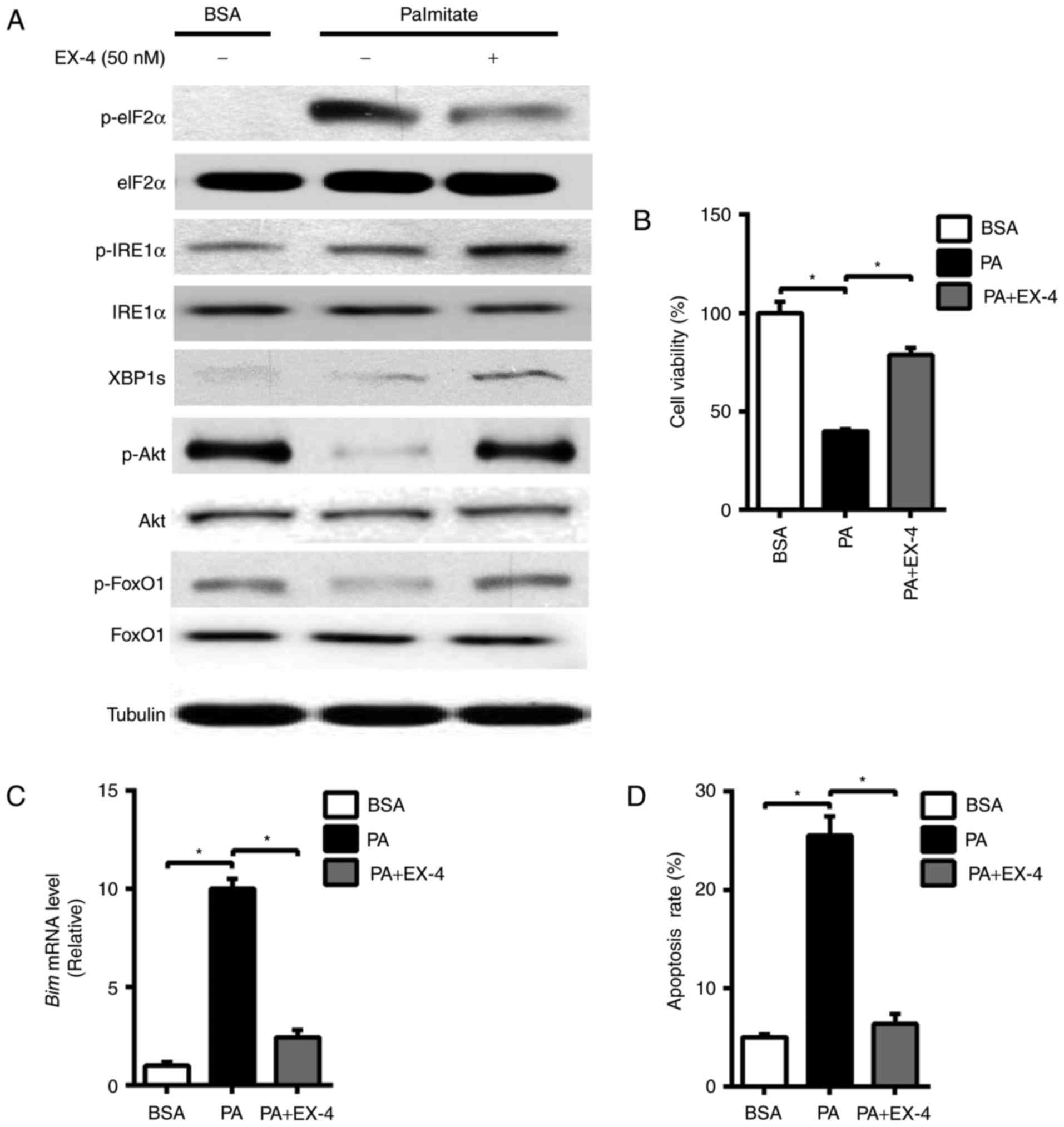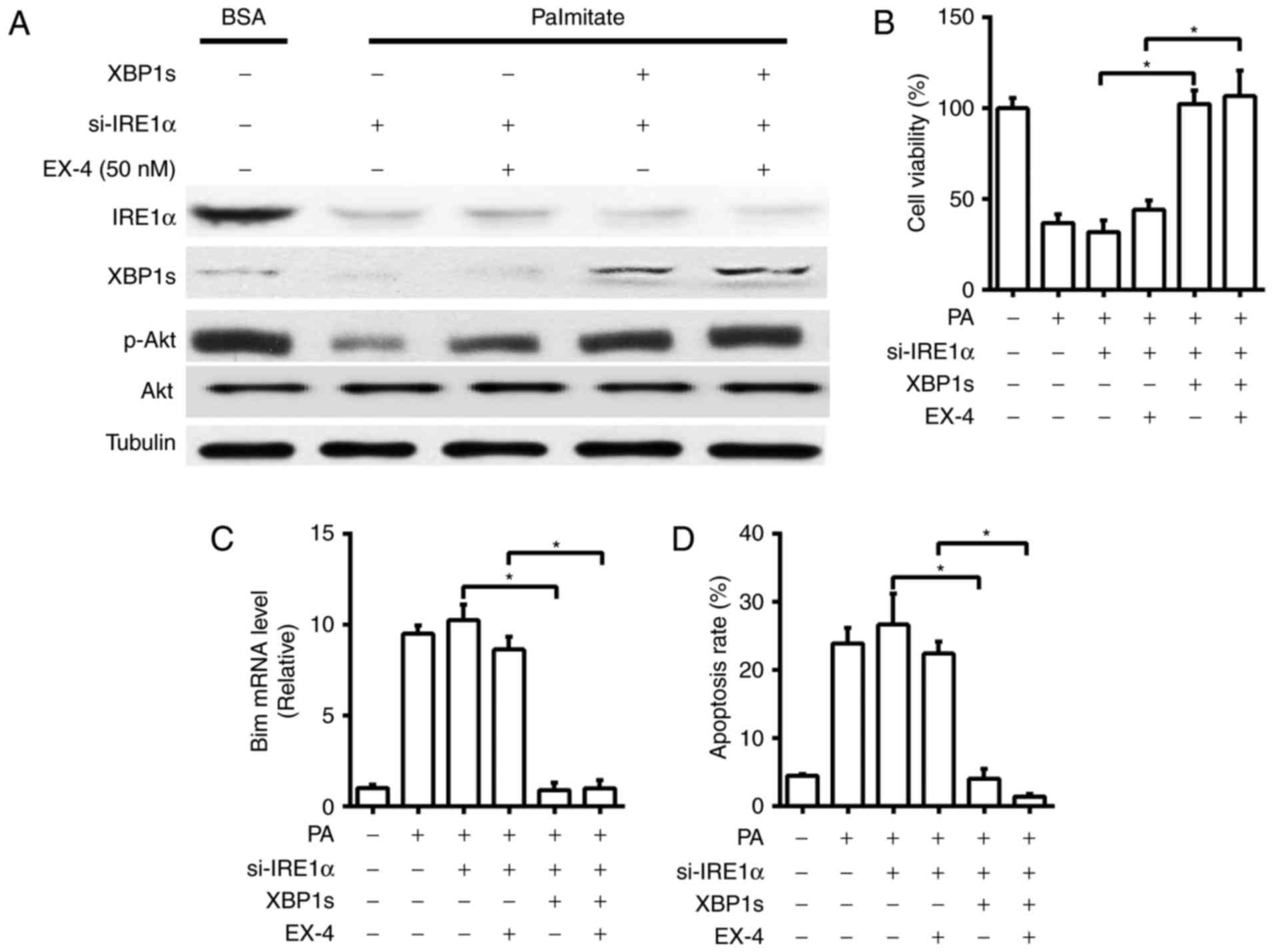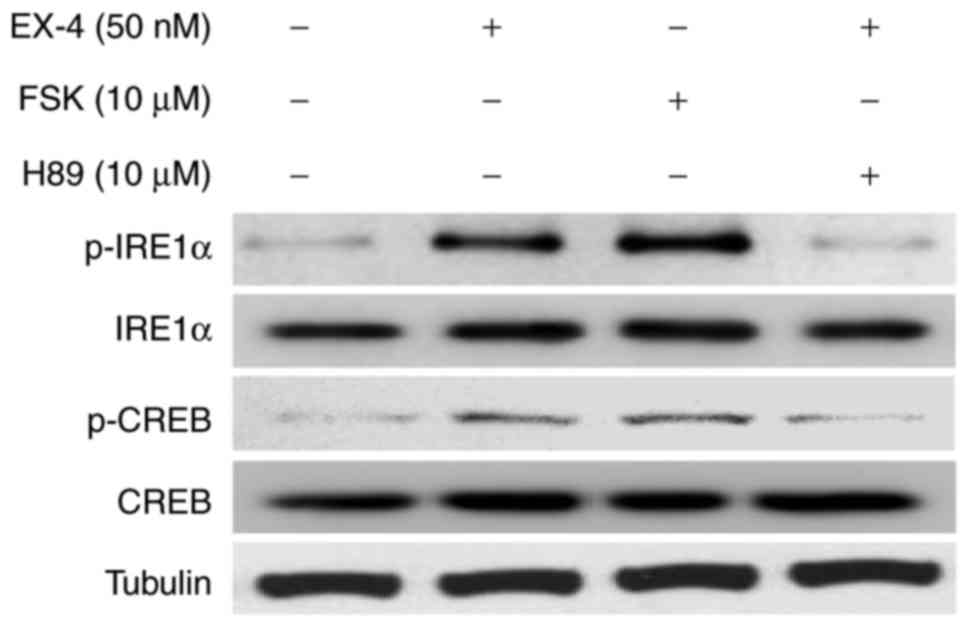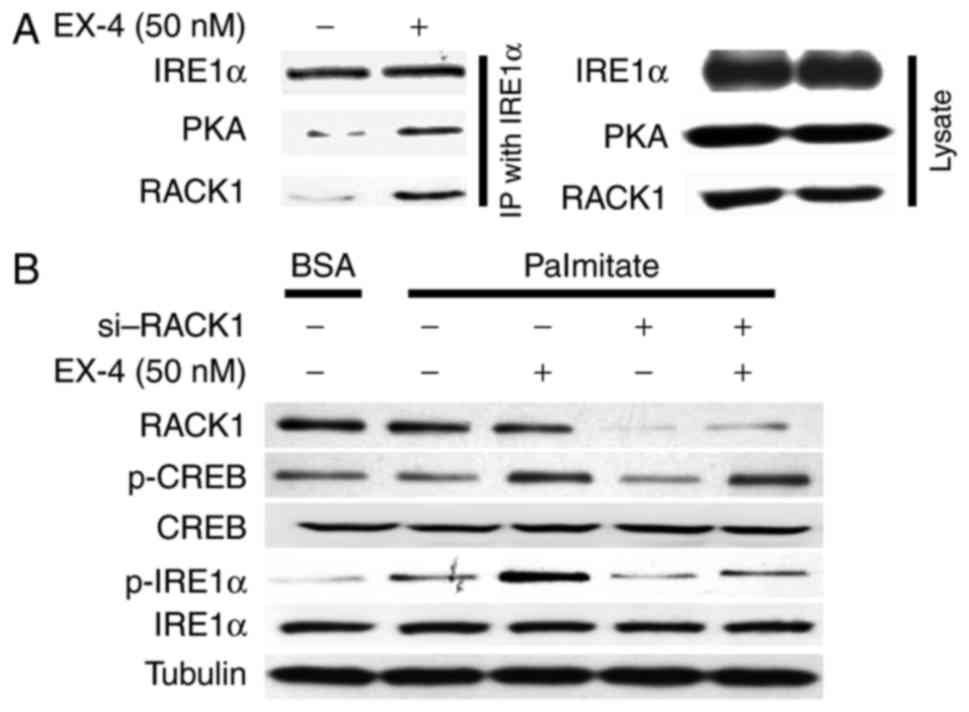|
1
|
Sachdeva MM and Stoffers DA: Minireview:
Meeting the demand for insulin: Molecular mechanisms of adaptive
postnatal beta-cell mass expansion. Mol Endocrinol. 23:747–758.
2009. View Article : Google Scholar : PubMed/NCBI
|
|
2
|
Lipson KL, Fonseca SG, Ishigaki S, Nguyen
LX, Foss E, Bortell R, Rossini AA and Urano F: Regulation of
insulin biosynthesis in pancreatic beta cells by an endoplasmic
reticulum-resident protein kinase IRE1. Cell Metab. 4:245–254.
2006. View Article : Google Scholar : PubMed/NCBI
|
|
3
|
Wajchenberg BL: Beta-cell failure in
diabetes and preservation by clinical treatment. Endocr Rev.
28:187–218. 2007. View Article : Google Scholar : PubMed/NCBI
|
|
4
|
Hetz C: The unfolded protein response:
Controlling cell fate decisions under ER stress and beyond. Nat Rev
Mol Cell Biol. 13:89–102. 2012. View
Article : Google Scholar : PubMed/NCBI
|
|
5
|
Ron D and Walter P: Signal integration in
the endoplasmic reticulum unfolded protein response. Nat Rev Mol
Cell Biol. 8:519–529. 2007. View
Article : Google Scholar : PubMed/NCBI
|
|
6
|
Bell GI and Polonsky KS: Diabetes mellitus
and genetically programmed defects in beta-cell function. Nature.
414:788–791. 2001. View
Article : Google Scholar : PubMed/NCBI
|
|
7
|
Mao T, Shao M, Qiu Y, Huang J, Zhang Y,
Song B, Wang Q, Jiang L, Liu Y, Han JD, et al: PKA phosphorylation
couples hepatic inositol-requiring enzyme 1alpha to glucagon
signaling in glucose metabolism. Proc Natl Acad Sci USA.
108:15852–15857. 2011. View Article : Google Scholar : PubMed/NCBI
|
|
8
|
Shamu CE and Walter P: Oligomerization and
phosphorylation of the Ire1p kinase during intracellular signaling
from the endoplasmic reticulum to the nucleus. EMBO J.
15:3028–3039. 1996.PubMed/NCBI
|
|
9
|
Welihinda AA and Kaufman RJ: The unfolded
protein response pathway in Saccharomyces cerevisiae.
Oligomerization and trans-phosphorylation of Ire1p (Ern1p) are
required for kinase activation. J Biol Chem. 271:18181–18187. 1996.
View Article : Google Scholar : PubMed/NCBI
|
|
10
|
Calfon M, Zeng H, Urano F, Till JH,
Hubbard SR, Harding HP, Clark SG and Ron D: IRE1 couples
endoplasmic reticulum load to secretory capacity by processing the
XBP-1 mRNA. Nature. 415:92–96. 2002. View
Article : Google Scholar : PubMed/NCBI
|
|
11
|
Lee K, Tirasophon W, Shen X, Michalak M,
Prywes R, Okada T, Yoshida H, Mori K and Kaufman RJ: IRE1-mediated
unconventional mRNA splicing and S2P-mediated ATF6 cleavage merge
to regulate XBP1 in signaling the unfolded protein response. Genes
Dev. 16:452–466. 2002. View Article : Google Scholar : PubMed/NCBI
|
|
12
|
Yoshida H, Matsui T, Yamamoto A, Okada T
and Mori K: XBP1 mRNA is induced by ATF6 and spliced by IRE1 in
response to ER stress to produce a highly active transcription
factor. Cell. 107:881–891. 2001. View Article : Google Scholar : PubMed/NCBI
|
|
13
|
Lin JH, Li H, Yasumura D, Cohen HR, Zhang
C, Panning B, Shokat KM, Lavail MM and Walter P: IRE1 signaling
affects cell fate during the unfolded protein response. Science.
318:944–949. 2007. View Article : Google Scholar : PubMed/NCBI
|
|
14
|
Xu T, Yang L, Yan C, Wang X, Huang P, Zhao
F, Zhao L, Zhang M, Jia W, Wang X and Liu Y: The IRE1α-XBP1 pathway
regulates metabolic stress-induced compensatory proliferation of
pancreatic β-cells. Cell Res. 24:1137–1140. 2014. View Article : Google Scholar : PubMed/NCBI
|
|
15
|
Drucker DJ: Glucagon-like peptide-1 and
the islet beta-cell: Augmentation of cell proliferation and
inhibition of apoptosis. Endocrinology. 144:5145–5148. 2003.
View Article : Google Scholar : PubMed/NCBI
|
|
16
|
Tsunekawa S, Yamamoto N, Tsukamoto K, Itoh
Y, Kaneko Y, Kimura T, Ariyoshi Y, Miura Y, Oiso Y and Niki I:
Protection of pancreatic beta-cells by exendin-4 may involve the
reduction of endoplasmic reticulum stress; in vivo and in vitro
studies. J Endocrinol. 193:65–74. 2007. View Article : Google Scholar : PubMed/NCBI
|
|
17
|
Achard CS and Laybutt DR: Lipid-induced
endoplasmic reticulum stress in liver cells results in two distinct
outcomes: Adaptation with enhanced insulin signaling or insulin
resistance. Endocrinology. 153:2164–2177. 2012. View Article : Google Scholar : PubMed/NCBI
|
|
18
|
Ren D, Sun J, Mao L, Ye H and Polonsky KS:
BH3-only molecule Bim mediates β-cell death in IRS2 deficiency.
Diabetes. 63:3378–3387. 2014. View Article : Google Scholar : PubMed/NCBI
|
|
19
|
McCahill A, Warwicker J, Bolger GB,
Houslay MD and Yarwood SJ: The RACK1 scaffold protein: A dynamic
cog in cell response mechanisms. Mol Pharmacol. 62:1261–1273. 2002.
View Article : Google Scholar : PubMed/NCBI
|
|
20
|
Buteau J, El-Assaad W, Rhodes CJ,
Rosenberg L, Joly E and Prentki M: Glucagon-like peptide-1 prevents
beta cell glucolipotoxicity. Diabetologia. 47:806–815. 2004.
View Article : Google Scholar : PubMed/NCBI
|
|
21
|
Scheid MP and Woodgett JR: PKB/AKT:
Functional insights from genetic models. Nat Rev Mol Cell Biol.
2:760–768. 2001. View
Article : Google Scholar : PubMed/NCBI
|
|
22
|
Hajduch E, Litherland GJ and Hundal HS:
Protein kinase B (PKB/Akt)-a key regulator of glucose transport?
FEBS Lett. 492:199–203. 2001. View Article : Google Scholar : PubMed/NCBI
|
|
23
|
Wrede CE, Dickson LM, Lingohr MK, Briaud I
and Rhodes CJ: Fatty acid and phorbol ester-mediated interference
of mitogenic signaling via novel protein kinase C isoforms in
pancreatic beta-cells (INS-1). J Mol Endocrinol. 30:271–286. 2003.
View Article : Google Scholar : PubMed/NCBI
|
|
24
|
Srinivasan S, Ohsugi M, Liu Z, Fatrai S,
Bernal-Mizrachi E and Permutt MA: Endoplasmic reticulum
stress-induced apoptosis is partly mediated by reduced insulin
signaling through phosphatidylinositol 3-kinase/Akt and increased
glycogen synthase kinase-3beta in mouse insulinoma cells. Diabetes.
54:968–975. 2005. View Article : Google Scholar : PubMed/NCBI
|
|
25
|
Cunha DA, Ladrière L, Ortis F,
Igoillo-Esteve M, Gurzov EN, Lupi R, Marchetti P, Eizirik DL and
Cnop M: Glucagon-like peptide-1 agonists protect pancreatic
beta-cells from lipotoxic endoplasmic reticulum stress through
upregulation of BiP and JunB. Diabetes. 58:2851–2862. 2009.
View Article : Google Scholar : PubMed/NCBI
|
|
26
|
Gilley J, Coffer PJ and Ham J: FOXO
transcription factors directly activate bim gene expression and
promote apoptosis in sympathetic neurons. J Cell Biol. 162:613–622.
2003. View Article : Google Scholar : PubMed/NCBI
|
|
27
|
Stahl M, Dijkers PF, Kops GJ, Lens SM,
Coffer PJ, Burgering BM and Medema RH: The forkhead transcription
factor FoxO regulates transcription of p27Kip1 and Bim in response
to IL-2. J Immunol. 168:5024–5031. 2002. View Article : Google Scholar : PubMed/NCBI
|
|
28
|
Dijkers PF, Birkenkamp KU, Lam EW, Thomas
NS, Lammers JW, Koenderman L and Coffer PJ: FKHR-L1 can act as a
critical effector of cell death induced by cytokine withdrawal:
Protein kinase B-enhanced cell survival through maintenance of
mitochondrial integrity. J Cell Biol. 156:531–542. 2002. View Article : Google Scholar : PubMed/NCBI
|
|
29
|
Dijkers PF, Medema RH, Lammers JW,
Koenderman L and Coffer PJ: Expression of the pro-apoptotic Bcl-2
family member Bim is regulated by the forkhead transcription factor
FKHR-L1. Curr Biol. 10:1201–1204. 2000. View Article : Google Scholar : PubMed/NCBI
|
|
30
|
Kitamura T, Nakae J, Kitamura Y, Kido Y,
Biggs WH III, Wright CV, White MF, Arden KC and Accili D: The
forkhead transcription factor Foxo1 links insulin signaling to Pdx1
regulation of pancreatic beta cell growth. J Clin Invest.
110:1839–1847. 2002. View Article : Google Scholar : PubMed/NCBI
|
|
31
|
Martinez SC, Tanabe K, Cras-Méneur C,
Abumrad NA, Bernal-Mizrachi E and Permutt MA: Inhibition of Foxo1
protects pancreatic islet beta-cells against fatty acid and
endoplasmic reticulum stress-induced apoptosis. Diabetes.
57:846–859. 2008. View Article : Google Scholar : PubMed/NCBI
|
|
32
|
Cunha DA, Gurzov EN, Naamane N, Ortis F,
Cardozo AK, Bugliani M, Marchetti P, Eizirik DL and Cnop M: JunB
protects β-cells from lipotoxicity via the XBP1-AKT pathway. Cell
Death Differ. 21:1313–1324. 2014. View Article : Google Scholar : PubMed/NCBI
|
|
33
|
Hu MC, Gong HY, Lin GH, Hu SY, Chen MH,
Huang SJ, Liao CF and Wu JL: XBP-1, a key regulator of unfolded
protein response, activates transcription of IGF1 and Akt
phosphorylation in zebrafish embryonic cell line. Biochem Biophys
Res Commun. 359:778–783. 2007. View Article : Google Scholar : PubMed/NCBI
|
|
34
|
Akiyama M, Liew CW, Lu S, Hu J, Martinez
R, Hambro B, Kennedy RT and Kulkarni RN: X-box binding protein 1 is
essential for insulin regulation of pancreatic α-cell function.
Diabetes. 62:2439–2449. 2013. View Article : Google Scholar : PubMed/NCBI
|
|
35
|
Laybutt DR, Preston AM, Akerfeldt MC,
Kench JG, Busch AK, Biankin AV and Biden TJ: Endoplasmic reticulum
stress contributes to beta cell apoptosis in type 2 diabetes.
Diabetologia. 50:752–763. 2007. View Article : Google Scholar : PubMed/NCBI
|
|
36
|
Winnay JN, Boucher J, Mori MA, Ueki K and
Kahn CR: A regulatory subunit of phosphoinositide 3-kinase
increases the nuclear accumulation of X-box-binding protein-1 to
modulate the unfolded protein response. Nat Med. 16:438–445. 2010.
View Article : Google Scholar : PubMed/NCBI
|
|
37
|
Lee AH, Heidtman K, Hotamisligil GS and
Glimcher LH: Dual and opposing roles of the unfolded protein
response regulated by IRE1alpha and XBP1 in proinsulin processing
and insulin secretion. Proc Natl Acad Sci USA. 108:8885–8890. 2011.
View Article : Google Scholar : PubMed/NCBI
|
|
38
|
Bregenholt S, Møldrup A, Blume N, Karlsen
AE, Nissen Friedrichsen B, Tornhave D, Knudsen LB and Petersen JS:
The long-acting glucagon-like peptide-1 analogue, liraglutide,
inhibits beta-cell apoptosis in vitro. Biochem Biophys Res Commun.
330:577–584. 2005. View Article : Google Scholar : PubMed/NCBI
|
|
39
|
Arimoto K, Fukuda H, Imajoh-Ohmi S, Saito
H and Takekawa M: Formation of stress granules inhibits apoptosis
by suppressing stress-responsive MAPK pathways. Nat Cell Biol.
10:1324–1332. 2008. View
Article : Google Scholar : PubMed/NCBI
|
|
40
|
López-Bergami P, Habelhah H, Bhoumik A,
Zhang W, Wang LH and Ronai Z: RACK1 mediates activation of JNK by
protein kinase C [corrected]. Mol Cell. 19:309–320. 2005.
View Article : Google Scholar : PubMed/NCBI
|


















